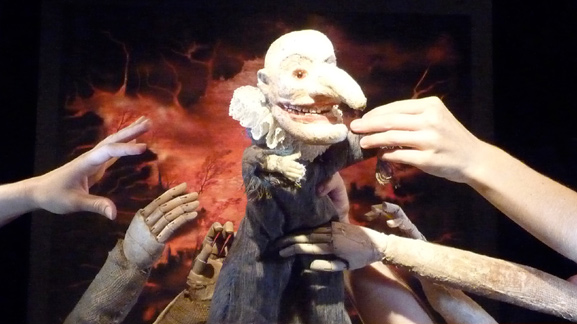
 BY BRANDON LAFVING FRINGE CORRESPONDENT The stage front appeared simple enough – an old wooden façade, an antique piano, and a banjo suitable for a ventriloquist’s doll. Then the hands came out. One at a time, each slid aside a false panel in the wall, bearing a gift to top off the scene. They brought: a miniature, sepia-hued globe, a mechanical metronome, a birdcage that would be more appropriate housing for a ladybug, and a toy cannon. Once these accoutrements had been added, the lead role, Mister Punch himself entered through a trap door and unlatched the metronome. The show had begun.
BY BRANDON LAFVING FRINGE CORRESPONDENT The stage front appeared simple enough – an old wooden façade, an antique piano, and a banjo suitable for a ventriloquist’s doll. Then the hands came out. One at a time, each slid aside a false panel in the wall, bearing a gift to top off the scene. They brought: a miniature, sepia-hued globe, a mechanical metronome, a birdcage that would be more appropriate housing for a ladybug, and a toy cannon. Once these accoutrements had been added, the lead role, Mister Punch himself entered through a trap door and unlatched the metronome. The show had begun.
The Devil and Mister Punch is staged at the Christ Church Neighborhood House, which is a scathingly brilliant choice, not only for the religious connotations that were prominent throughout the show – sin, guilt, murder, and consequent punishment – but also for the structure’s age. The wooden stage front and the relic-like remains of a piano were squeezed in between two red brick walls that looked like they were built at the turn of the last century, during the height of vaudeville. The windows, high up on the walls near the vaulted ceiling, had been covered over by gritty cement to ink out the starry night.
It was clear from the beginning that the puppeteers were true entertainers, virtuosos in fact. Most were capable musicians and actors, as well, and they switched between roles seamlessly. Each action demonstrated the studied showmanship to come out of the vaudevillian era. More impressive than this fact, though, were the scenes in which the puppeteers were revealed as they worked. Although it seems like this tactic would be distracting, it actually added to the illusion. Each puppeteer would be so focused, so bent to his/her activity that my gaze would turn to the puppet and willfully forget that the hands were there. For the cast of The Devil and Mister Punch, their performance was not an art; it was at the very least a ritual, definitely a compulsion, and most probably an addiction. Such was the team’s cohesion of purpose.
Costume design was equally provocative. The puppets were handcrafted from papier-mâché. Many were as misshapen as the foul characters they represented. This unsettling yet strangely compelling ugliness was nonetheless finished with rouge, dotted with freckles and moles, and besot with an almost inhuman attention to detail. But perhaps even more captivating was the script and plot, which acted and interacted on multiple levels. Puppeteers and musicians alike became players in a tragically hilarious drama that unfolded alongside the puppet show. While Mister Punch came closer and closer to hell, a tragic romance unfolded between a washed-up puppeteer and the beautiful double bassist. Rather than detracting value, as is usually the case with tactics of this sort, both plots lent symbolic value to each other, an artistic feat that I have never seen implemented so flawlessly.
(This is not co-artistic director Julian Crouch’s first triumph, as he is the recipient of a 2002 Laurence Olivier Award and co-directed/designed Broadway hit Shockheaded Peter, among other triumphs.)
The Devil and Mister Punch is sinfully dark. It reaches past the gates of hell to tell its story, culminating in a chilling scene in which the devil himself is set free to strike terror in the audience. No one who looks into those obsidian orbs will ever forget that prideful, domineering stare. This is more than impressive considering the fact that the devil, I realize now, was a mere puppet. Yet it was a reality that so forcefully gripped my imagination, it created a truth that superseded my own. Dark comedy has never been more paradoxically delectable.
THE DEVIL AND MISTER PUNCH RUNS NIGHTLY THROUGH FRIDAY AT CHRIST CHURCH NEIGHBORHOOD HOUSE
